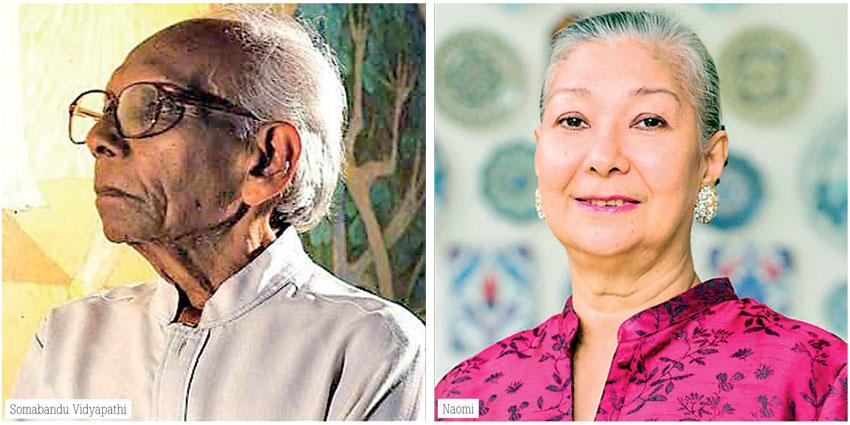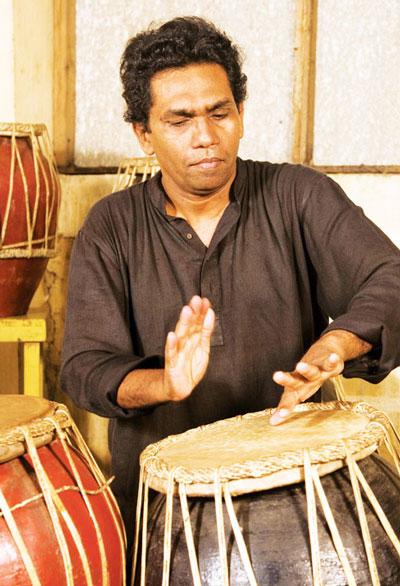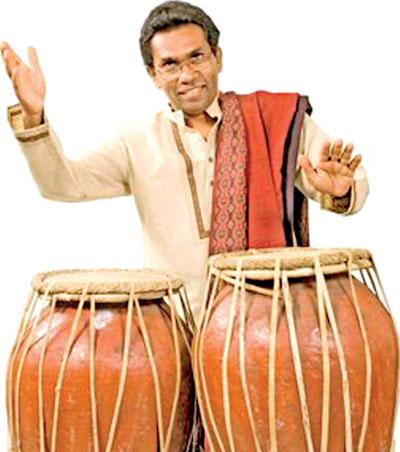19 Mar 2022 - {{hitsCtrl.values.hits}}

 After a lapse of two years, I returned to Sri Lanka and spent some rewarding time with two of my greatest friends. Our continuing relationships are cemented by a lifelong love for dance. Dance is the premise on which we met, became friends and it remains pivotal to almost every conversation we have.
After a lapse of two years, I returned to Sri Lanka and spent some rewarding time with two of my greatest friends. Our continuing relationships are cemented by a lifelong love for dance. Dance is the premise on which we met, became friends and it remains pivotal to almost every conversation we have.
Naomi Rajaratnam was my dance partner (until I left Sri Lanka in 1987) with whom I explored many avenues of contemporary dance and classical ballet. Ravibandu Vidyapathy is an esteemed Kandyan dancers who is also a master in the art of Kathakali. He is also considered to be one of the foremost Tabla virtuosos in Asia. I met Ravi through my other dance partner, the effervescent and fabulous Khema.
When I returned this year, I was curious to know the progress that had been made within the world of dance and choreography, especially among the dancers I used to work with in the past.
As we all know, dance in Sri Lanka is split into two separate halves. There is traditional dance and western dance. Rarely do we find dancers who move between the two extremes. I have been privileged to have worked with these two varying styles in the past when I used to be a dancer. On this visit I encountered a new generation of dancers who have a solid background in traditional dance forms and are effortlessly at ease with Latin American dance too. The rapid influx of Latin America dance into Sri Lanka was a subject that I wrote about in my thesis back in 2003. As I observed then segregation in our schooling system, our traditional upbringing and the desire to be seen as “westernised” plus the added advantage of mixing with those of the opposite sex, popularised this dance from to such an extent that schools have mushroomed all over the island. The requirements of a  Latin American dance class vaults over and shuns the strict discipline that is required by those who attend classes in Classical Ballet and Kandyan dance in a way that it seems less tedious and boring and much more fun. To add to this, students of Classical, Kandyan and Contemporary dance very rarely get a chance to perform. An annual school concert may be the most that they can aspire to, unless of course the school get the funding or sponsorship to produce a full-on show (which is a rarity). Whereas, the Latin American dance community are constantly participating in competitions and demonstrations, and called upon to provide entertainment at weddings conferences, conventions and coffee mornings. The upbeat fun and sizzle are certainly contagious and the younger generations are drawn to it in droves.
Latin American dance class vaults over and shuns the strict discipline that is required by those who attend classes in Classical Ballet and Kandyan dance in a way that it seems less tedious and boring and much more fun. To add to this, students of Classical, Kandyan and Contemporary dance very rarely get a chance to perform. An annual school concert may be the most that they can aspire to, unless of course the school get the funding or sponsorship to produce a full-on show (which is a rarity). Whereas, the Latin American dance community are constantly participating in competitions and demonstrations, and called upon to provide entertainment at weddings conferences, conventions and coffee mornings. The upbeat fun and sizzle are certainly contagious and the younger generations are drawn to it in droves.
There are also those traditional troupes that have also catered to this commercialisation by creating a fusion of techniques, none of which have been thought through or explored properly. They have recreated Kandyan dance by mixing it with western techniques and trashy Bollywood glitz which the audience cannot get enough of! This quick-fix vulgarisation of dance sells very well. At first glance It appears to be traditional dance but if you examine it deep enough you realise that its traditional dance with its soul ripped out. And in my opinion, it’s a freeway to a dead end. I say this only because the younger generation of dancers in Sri Lanka are slaves to social media, especially to Instagram and Tik-Tok. They live their lives by displaying every bump, grind, hump, split, arse twirl and crotch swivel to the entire world. They learn their dance moves by imitating what they see on video’s, YouTube and Instagram.
They spare no thought at all about the technique that informs the body how a particular position or pose should be achieved. They seek short cuts in search of instance fame which some of them do achieve. This energetic younger generation have not thought of the day when their svelte bodies will lose their power. They have not asked themselves about what will happen when make-up cannot cover their ageing faces. But most importantly, they do not ask themselves if they have anything to pass on to the generation that follows them. This is where the perseverance of those who have in-depth knowledge of correct technique and the discipline that any dance form deserves, comes into play. Naomi and Ravi have always kept a level of professionalism in their pursuit of dance and the teaching of it, without even a thought of making a profit out of their talents.
At the time I left Sri Lanka I had a wonderful group of dancers who learnt to dance with me. I never got paid a cent for the classes I gave. I had the privilege of living in a large house where the hall was big enough to hold a class for about sixteen dancers at a time. The furniture used to be flung out into the garden whilst we had our dancing classes. These classes stretched way beyond the 90-minute duration because we tended to explore and experiment till quite late in the evenings. All of us were extremely fit and used to workout frequently and do numerous aerobic classes in order to have the right physique for dancing. Seeing the way in which Ravi and Naomi deal with their dancers and troupes, reminded me, of me. The similarity is that we all dance because we love the dance and if we make some money along the way so be it! But at the end, it’s the dancing and the teaching of it that is our wealth.
When I met Naomi this year, I asked her why she switched from Classical Ballet to Latin American dance forms. Her answer was simple. “You left,” she said, “and the only other place that I could follow my passion for dance was to join a Latin and Ballroom school where my interests for these technique’s grew.” Naomi has a keen eye for the intricacies of technique, it is sharper than most people I’ve ever known. She will find the slightest gap in the placement of a dancer’s feet and go on and on and on, until its correct. This is indeed her forte and this is the key reason that she has attracted some of the finest dancers in Colombo to work with her.
 All through her career. she was particularly driven to getting the costumes perfect. Down to the shoes, the nails, the hairstyles, the make-up, the even the skin tone on the elbows and knees is supervised keenly. No expense is spared if it goes towards achieving the right look for the dance work being performed on stage. Having frequent chats with Naomi (after watching her rehearsals) I realised that she is gradually trying to coach the dancers to perform the way she sees the Latin techniques. Elegant and not vulgar. Understated sensuality and not in-your-face sexuality. This is a very tough hill to climb, simply because she is working with dancers who revel in doing the exact opposite.
All through her career. she was particularly driven to getting the costumes perfect. Down to the shoes, the nails, the hairstyles, the make-up, the even the skin tone on the elbows and knees is supervised keenly. No expense is spared if it goes towards achieving the right look for the dance work being performed on stage. Having frequent chats with Naomi (after watching her rehearsals) I realised that she is gradually trying to coach the dancers to perform the way she sees the Latin techniques. Elegant and not vulgar. Understated sensuality and not in-your-face sexuality. This is a very tough hill to climb, simply because she is working with dancers who revel in doing the exact opposite.
She admits that it is quite impossible for young dancers to make a living by dancing elegantly as blatant sexuality is very marketable. The evidence in clear when one sees some of these young dancers perform. But Naomi’s drive is to train the dancers she is working with, to perform the way she wants for her show, to know their bodies well enough to be able to interpret a choreographer’s intention, to be able to control their bodies by learning the inner discipline of a technique. She is adamant that her dancers will be able to demonstrate the subtle difference between the Jive, the Rumba, the Paso Doble, the Samba, the Tango, etc. when they are performing and bemoans the fact that (at the moment) “they all dance as if they are going to kill each other and every dance tends to look the same!”
After having been through one of the most horrendous years where she has had to overcome several health issues, Naomi’s drive and commitment to presenting a show remains undiminished. This is due to her faith. Her choreography is an attempt to reveal that faith through the joy of dance. Some may find it difficult to make a connection between faith and Latin American dance, but those of us who have lived in Sri Lanka most of our lives have witnessed rituals and traditional dances that are awash with religious significance and we don’t even bat an eyelid when we see these performances. When we look back at the history of dance around the world, we can see that there are several choreographers who have approached their work through a sense of spirituality.
Naomi’s challenge will be to present a body of work where the audience can identify this sense of spirituality and energy. I am hoping that her forthcoming show reflects the absolute joy that dance can bring to all of us. The group of dancers she is working with are simply superb. They are without a doubt some of the best that I have seen in Sri Lanka. There is no doubt that they will deliver some stellar performances. However, if they pay extra attention to the detailed instructions she gives them, all of them will have the capability of being great artists - instead of being just another mundane performer who is forgotten once they leave the spotlight.
In mid-January, Ravibandu invited me and quite a few of Sri Lanka’s dance fraternity to watch some of his new pieces of choreography at his new studio space in Nawala. Whilst watching these new pieces I realised that Ravi is moving in the direction of pure movement incorporated with the expressive techniques from the Indian dance traditions. At first it reminded me of the works of Ruth St Denis and Ted Shawn. The pieces also had a resemblance to works done by Rudolf Laban and Isadora Duncan, They were free and untrammelled. They were completely removed from the constraints of his traditional background and were expressions of natural movement with the occasional touch of a traditional motif. Here was a choreographer exploring a direction which is new, he seems quite unafraid of the radical change in direction that he was on and later told me that he wishes to work with dancers of other traditions (especially with dance companies abroad) just to see what can be accomplished. Knowing his expertise in both the Kandyan dance and Kathakali techniques it seemed as if he has taken some artistic license to create and explore the immense possibilities that can be expressed through the human body that is not trapped in tradition.
Though some may not be encouraged with the direction that Ravi is moving in, it reveals a confident choreographer who is untethered by his deep links to traditional dance. It is only when someone is supremely confident of his base and foundation that one can leap into the unknown. After all, Picasso who is known for creating cubism took a leap of faith away from the classical technique of painting that was his initial foundation and look where that got him!
Unlike most of the other traditional dancers who are creating new works, Ravi works with western classical music and uses the Bible, the complete works of Shakespeare and other pieces of great literature (Russian and Japanese among them) as his sources of inspiration His productions of Judas, Macbeth and Othello are examples of the path he is hoping to expand on.
When it comes to costuming, Ravi is the exact opposite of Naomi, he strips his costuming down to the bare minimum, much to the detriment of many other traditional dance teachers who deride his desire for simple and clear lines and colours. Should he desire to adorn his dancers in fantastic costumes, Ravi is the one person who could excel at this, after all he is the son of the great artist and designer Somabandu whose designs for Kandyan dance will never be surpassed for generations to come. Ravi is also blessed with the values of sincerity, simplicity and a wealth of knowledge on arts and culture.
These are indeed the qualities he has inherited from his late father who was without a doubt, a true genius. Ravi is sure to continue to on his path of creativity and experimentation simply because of his love for the art of dance.
Both Naomi and Ravi will face many a criticism for the paths they have chosen. But I have the greatest admiration for the courage they are both showing in forging their own way and breaking away from the age-old constraints so that they can remain creative and provide the younger generation of dancers with an unshakeable foundation of good technique and great role models on which to build their futures on. For my part, I feel entirely at ease in telling them my views and opinions on their creative progress and I know they will do the same for me. After all, progress can only be made by facing the truth about the work you do. I salute them both for stepping into the unknown, going off on a whim and staying constantly creative just so that they can keep the dance alive for as long as they can. Their steadfastness in working with dancers throughout the ghastly few years we have been though, shines like a beacon in the darkness. As the great modern dance choreographer Merce Cunningham stated, “you have to love dancing to stick to it. It gives you nothing back, no manuscripts to store away, no paintings to show on walls and maybe hang in museums, no poems to be printed and sold, nothing but that fleeting moment when you feel alive. It is not for unsteady souls.”
04 Jan 2025 24 minute ago
04 Jan 2025 52 minute ago
04 Jan 2025 3 hours ago
03 Jan 2025 03 Jan 2025
03 Jan 2025 03 Jan 2025